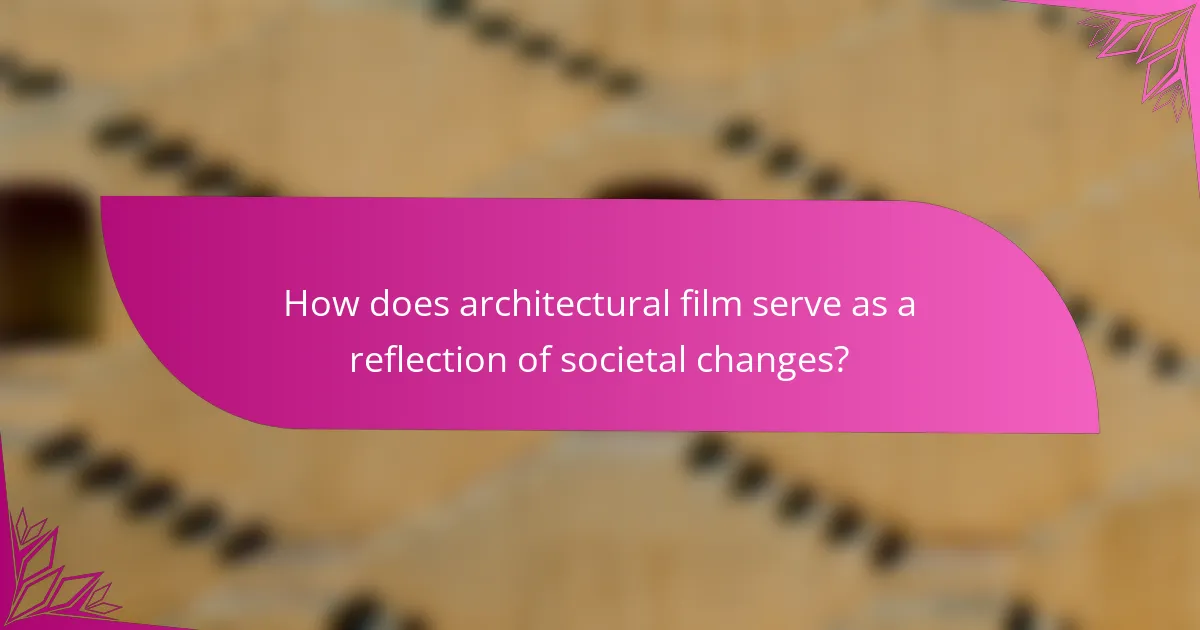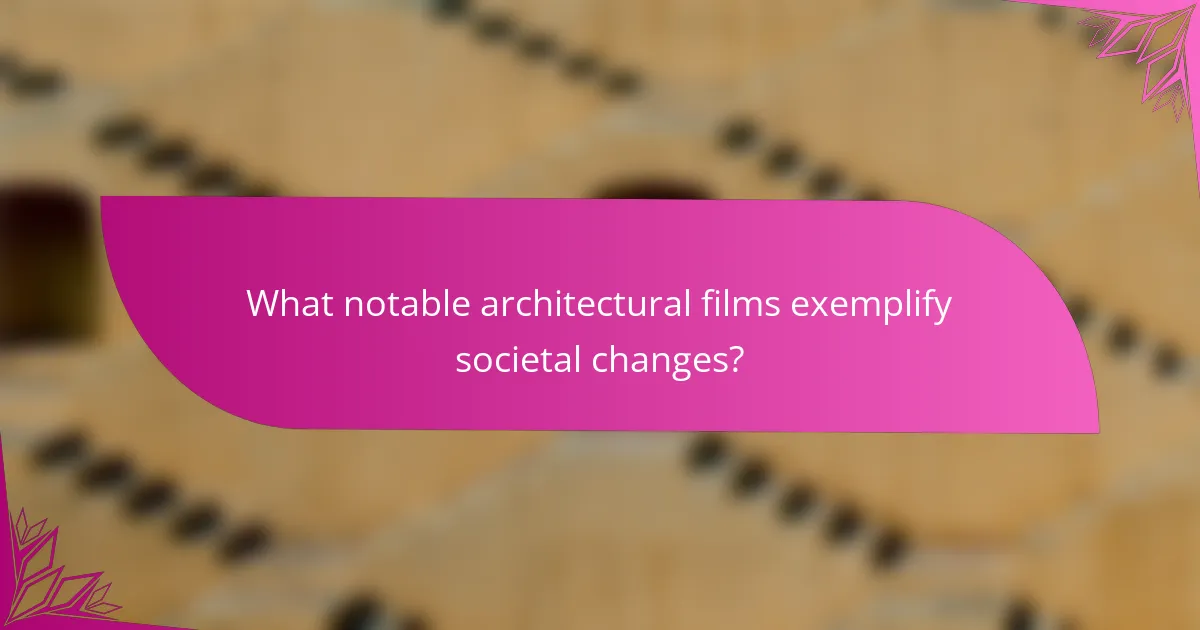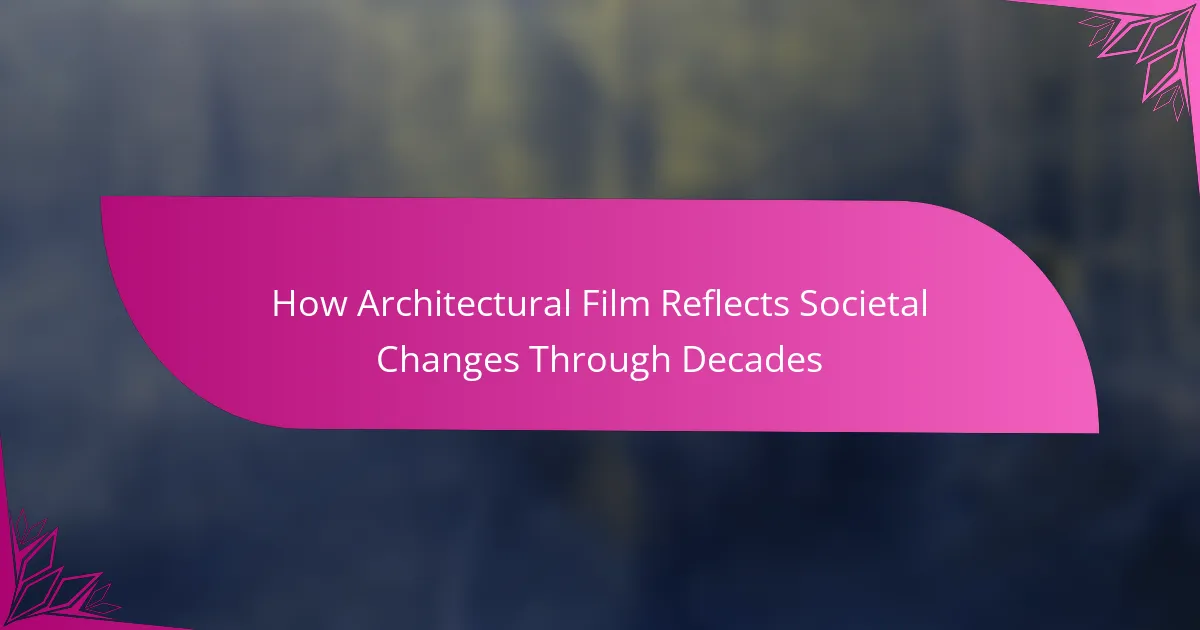Architectural film is a medium that visually documents the evolution of architectural styles and urban landscapes, reflecting societal changes over time. This article examines how architectural films capture shifts in cultural values, technological advancements, and economic conditions, highlighting significant themes such as modernism, sustainability, class struggle, and urban decay. Key films like “Metropolis,” “Blade Runner,” and “The Fountainhead” illustrate the relationship between architecture and societal conflicts, offering insights into historical contexts and priorities. Additionally, the article discusses methods for critically engaging with architectural films, emphasizing the importance of understanding the socio-political climate and the filmmakers’ choices. Through this analysis, readers will gain a deeper appreciation of architecture’s role in shaping and reflecting societal values.

How does architectural film serve as a reflection of societal changes?
Architectural film serves as a reflection of societal changes by visually documenting the evolution of architectural styles and urban landscapes. It captures shifts in cultural values, technological advancements, and economic conditions through the built environment. For instance, films from the mid-20th century often showcase modernist architecture, reflecting post-war optimism and industrial growth. In contrast, contemporary films may highlight sustainable architecture, indicating a societal shift towards environmental awareness. Architectural films also explore social issues, such as housing crises or urban decay, illustrating the impact of policy decisions on communities. By analyzing these films, viewers gain insights into the historical context and societal priorities of different eras.
What are the key themes in architectural films across different decades?
Key themes in architectural films across different decades include modernism, postmodernism, urbanization, and sustainability. In the 1920s and 1930s, modernism emphasized functionality and simplicity, reflecting the industrial age. The 1960s and 1970s saw postmodernism challenge modernist ideals, introducing eclectic styles and historical references. Urbanization became prominent in the 1980s and 1990s as cities expanded, focusing on architecture’s role in urban life. In recent decades, sustainability emerged as a key theme, addressing environmental concerns and promoting eco-friendly designs. Each theme reflects the societal values and challenges of its time, showcasing the evolving relationship between architecture and culture.
How do architectural styles depicted in films mirror societal values?
Architectural styles in films reflect societal values by showcasing cultural priorities and historical contexts. For instance, Art Deco in 1920s films symbolizes luxury and modernity. This mirrors the societal fascination with progress and wealth during that era. Similarly, Brutalism in post-war cinema often represents utilitarianism and social reform. It highlights the emphasis on functionality and community in a time of rebuilding. Additionally, contemporary films featuring sustainable architecture reflect current environmental values. They indicate a growing societal awareness of ecological issues. Thus, architectural styles serve as visual narratives that encapsulate the evolving values and aspirations of society over time.
What role does urban development play in the narratives of architectural films?
Urban development serves as a critical backdrop in architectural films. It shapes the narrative by reflecting societal values and changes over time. The evolution of urban landscapes often mirrors shifts in culture, economy, and technology. Architectural films frequently highlight iconic structures that symbolize progress or decline in urban settings. For instance, films may depict gentrification, showcasing its impact on communities and architecture. Such narratives can provoke discussions about social equity and sustainability. Urban development also influences character arcs, as individuals navigate spaces that define their experiences. Overall, the portrayal of urban development enriches the storytelling in architectural films by embedding deeper societal commentary.
Why is it important to analyze architectural films in the context of societal shifts?
Analyzing architectural films in the context of societal shifts is important because these films reflect cultural values and societal changes. Architectural films often showcase the built environment, which is influenced by social, political, and economic factors. For example, the rise of modernism in the 20th century coincided with significant social transformations, such as urbanization and industrialization.
These films serve as visual documentation of how architecture responds to societal needs and aspirations. They can illustrate shifts in aesthetics, technology, and functionality over time. Additionally, architectural films can reveal public sentiment about urban development, sustainability, and community identity.
By examining these films, researchers and viewers can gain insights into historical contexts and the evolution of societal norms. Architectural films thus act as a lens through which we can understand broader societal dynamics and their implications for future built environments.
How can architectural films influence public perception of urban spaces?
Architectural films can significantly influence public perception of urban spaces by shaping narratives around architecture and design. They present visual representations that can evoke emotions and provoke thought about urban environments. These films often highlight the functionality and aesthetic value of spaces, altering how viewers perceive their surroundings. For example, films like “Koolhaas Houselife” showcase the intricate relationship between architecture and daily life. This can lead to increased appreciation for innovative designs and urban planning. Furthermore, architectural films can address social issues related to urban spaces, prompting discussions on accessibility and sustainability. By portraying both the beauty and challenges of urban settings, these films can inspire community engagement and activism.
What insights can we gain from the evolution of architectural film over time?
Architectural film has evolved to reflect societal changes over time. Initially, it focused on showcasing architectural innovations. As society progressed, films began to address cultural and social issues. The depiction of urbanization and modernism became prevalent in the mid-20th century. In recent years, sustainability and community engagement have emerged as key themes. This evolution mirrors shifts in public interest and values. For instance, films from the 1960s often highlighted the impact of industrialization. Contemporary films frequently explore the relationship between architecture and environment. This trajectory reveals how architectural film serves as a cultural lens.

What notable architectural films exemplify societal changes?
“Metropolis” exemplifies societal changes through its depiction of class struggle and industrialization. Released in 1927, it portrays a dystopian future where the divide between the wealthy and the working class is stark. The film’s architecture reflects the tension between progress and exploitation. “Blade Runner,” released in 1982, showcases urban decay and corporate dominance. Its futuristic cityscape highlights themes of environmental degradation and societal fragmentation. “The Fountainhead,” from 1949, presents individualism versus collectivism through architectural design. It emphasizes the importance of personal vision in a conformist society. These films illustrate how architecture mirrors societal values and conflicts over time.
How do specific films illustrate the relationship between architecture and society?
Specific films illustrate the relationship between architecture and society by depicting how built environments shape human experiences. For example, “Metropolis” showcases a dystopian future where architecture reflects social hierarchies. The towering structures symbolize power, while the workers live in oppressive conditions below. Similarly, “Blade Runner” portrays a fragmented society through its chaotic urban landscape. The film’s architecture highlights themes of isolation and consumerism. “The Fountainhead” presents the struggle of an individual architect against societal norms. This film emphasizes the conflict between creativity and conformity in architecture. Each of these films uses architectural elements to comment on social issues, thus illustrating the profound connection between the two.
What architectural movements are highlighted in these films?
Modernism and Postmodernism are architectural movements highlighted in these films. Modernism emphasizes minimalism and functionality, often seen in films showcasing sleek lines and open spaces. Postmodernism, in contrast, embraces eclecticism and historical references, appearing in films that feature playful forms and mixed styles. These movements reflect broader societal changes, such as shifts in cultural values and aesthetics. The films illustrate how architecture responds to contemporary issues, including urbanization and identity.
How do filmmakers use architecture to comment on social issues?
Filmmakers use architecture to comment on social issues by visually representing societal structures and cultural values. Architectural elements can symbolize power dynamics, socioeconomic status, and community identity. For instance, towering skyscrapers often depict corporate dominance and urban isolation. In contrast, dilapidated buildings may reflect neglect and poverty in marginalized communities.
Films like “Metropolis” showcase futuristic architecture to critique class disparity. “Parasite” uses contrasting homes to illustrate wealth inequality. These visual cues enhance storytelling and provoke audience reflection on real-world issues. Through architecture, filmmakers convey complex social narratives effectively and memorably.
What impact do these films have on contemporary architectural discourse?
Architectural films significantly influence contemporary architectural discourse. They shape public perception of architecture and urbanism. These films often highlight pressing social issues. They encourage discussions on sustainability, community, and identity. For example, films like “Citizen Jane: Battle for the City” critique urban planning practices. They inspire architects to consider social implications in their designs. Furthermore, these films serve as educational tools. They engage audiences in architectural history and theory. By doing so, they foster a deeper understanding of the built environment.
How do modern filmmakers draw inspiration from past architectural films?
Modern filmmakers draw inspiration from past architectural films by analyzing their visual storytelling techniques. They study how these films portray architectural styles and societal values. Filmmakers often reference iconic structures and their historical significance. They also emulate the cinematographic styles that highlight architectural details. Additionally, narratives in past films are reinterpreted to reflect contemporary issues. For example, films like “Metropolis” influence modern depictions of urban environments. The emotional resonance of architecture in past films informs character development in new narratives. By integrating these elements, filmmakers create a dialogue between past and present architectural themes.
What lessons can current architects learn from historical representations in film?
Current architects can learn about design evolution and societal values from historical representations in film. Films often showcase architectural styles that reflect the cultural and technological contexts of their time. For example, the depiction of modernism in films from the mid-20th century highlights the shift towards minimalism and functionality. This can inform architects about the importance of adapting to changing aesthetics and user needs.
Additionally, films can illustrate the impact of architecture on social interactions and urban development. Movies set in specific historical periods often reveal how architecture influences community dynamics. Understanding these representations helps architects create spaces that foster social engagement.
Moreover, historical films can serve as case studies for successful and unsuccessful architectural projects. Observing how buildings are portrayed can provide insights into public perception and acceptance. This knowledge can guide architects in their design decisions to better align with community expectations.
In summary, historical representations in film offer valuable lessons on design trends, social impact, and community engagement for current architects.

How can viewers critically engage with architectural films?
Viewers can critically engage with architectural films by analyzing their themes, aesthetics, and narratives. This involves examining how the films represent architectural concepts and societal values. Viewers should consider the historical context of the architecture depicted. Understanding the socio-political climate during the film’s production enhances comprehension. Analyzing the filmmakers’ choices in framing and editing reveals underlying messages. Engaging with critiques and discussions about the films can provide diverse perspectives. Additionally, comparing architectural films to real-world architectural practices can deepen insights. This method encourages a holistic understanding of architecture’s role in society.
What questions should viewers ask when watching architectural films?
Viewers should ask specific questions to enhance their understanding of architectural films. They can inquire about the historical context of the buildings featured. Understanding the timeframe helps in grasping societal changes. Viewers should also consider the architectural styles presented. Different styles reflect varying cultural values and technological advancements.
Another question is about the filmmakers’ perspectives. Knowing their intent can reveal biases or themes. Viewers should examine how the film portrays the relationship between architecture and society. This includes understanding how buildings influence social interactions.
Additionally, viewers can ask about the impact of architecture on the environment. Sustainable design is increasingly relevant in modern films. Finally, questioning the representation of diverse communities in architecture is essential. This highlights inclusivity and the evolution of societal values.
How can viewers analyze the portrayal of space and place in these films?
Viewers can analyze the portrayal of space and place in these films by examining the architectural elements depicted. They should focus on how these elements reflect societal values and cultural contexts. Analyzing the setting can reveal insights into the time period and the characters’ relationships with their environment. Viewers can also consider the use of color, lighting, and camera angles to understand the emotional tone associated with the spaces. Additionally, comparing different films can highlight shifts in architectural styles and urban planning over time. Historical context can provide a deeper understanding of the significance of the portrayed spaces. For example, films set in post-war eras may showcase utilitarian architecture reflecting societal needs. Overall, a detailed analysis of these aspects can illuminate how space and place shape narratives and character development in architectural films.
What role does the viewer’s own context play in interpreting architectural films?
The viewer’s own context significantly influences their interpretation of architectural films. Context includes personal experiences, cultural background, and societal influences. These factors shape how viewers perceive architectural styles and narratives. For instance, a viewer from an urban environment may focus on functionality and modernity. In contrast, someone from a rural background may appreciate traditional aesthetics. Research shows that individual experiences lead to varied emotional responses to architectural representations. A study by M. S. R. M. K. (2020) highlights that viewers’ interpretations are often aligned with their life experiences and cultural contexts. This indicates that context is crucial for understanding the deeper meanings in architectural films.
What are some best practices for studying the intersection of architecture and film?
To study the intersection of architecture and film effectively, one should analyze films that prominently feature architectural elements. This involves examining how architecture influences narrative and character development. Additionally, researching the historical context of both fields can provide insights into societal changes reflected in film. Engaging with architectural theory helps to understand the visual language used in films. Attending film screenings and architectural exhibitions can enhance observational skills. Collaborating with professionals from both disciplines fosters a comprehensive understanding. Lastly, documenting findings through essays or presentations solidifies knowledge and encourages further exploration.
How can interdisciplinary approaches enhance understanding of architectural films?
Interdisciplinary approaches enhance understanding of architectural films by integrating insights from various fields. These fields include architecture, film studies, sociology, and cultural studies. Each discipline contributes unique perspectives on how architecture influences and reflects societal values. For example, architecture provides context on design and space usage. Film studies analyze narrative techniques and visual storytelling. Sociology examines audience reception and cultural impact. By synthesizing these perspectives, a richer analysis emerges. This approach reveals how architectural films comment on historical and social contexts. Research shows that films like “Metropolis” illustrate societal anxieties about industrialization and urbanization. Thus, interdisciplinary approaches deepen the comprehension of architectural films and their societal implications.
What resources are available for further exploration of architectural film analysis?
Key resources for exploring architectural film analysis include academic journals, books, and online databases. Journals such as “The Journal of Architecture” and “Architectural Review” often publish articles on film analysis related to architecture. Books like “Film Architecture: Set Designs from Metropolis to Blade Runner” provide in-depth insights into the relationship between film and architecture. Online platforms like JSTOR and Google Scholar offer access to scholarly articles and papers on the subject. Additionally, film studies websites and architectural forums can provide valuable discussions and critiques. These resources collectively enhance understanding of how architectural representations in film reflect societal changes.
The main entity of the article is architectural film, which serves as a visual documentation of societal changes over decades. The article explores how architectural films reflect evolving cultural values, technological advancements, and economic conditions through key themes such as modernism, postmodernism, urbanization, and sustainability. It discusses the impact of urban development on narratives and character experiences, as well as the significance of analyzing architectural films to gain insights into historical contexts and societal priorities. Notable films exemplifying these concepts are highlighted, illustrating the relationship between architecture and society, and the influence of these films on contemporary architectural discourse.
